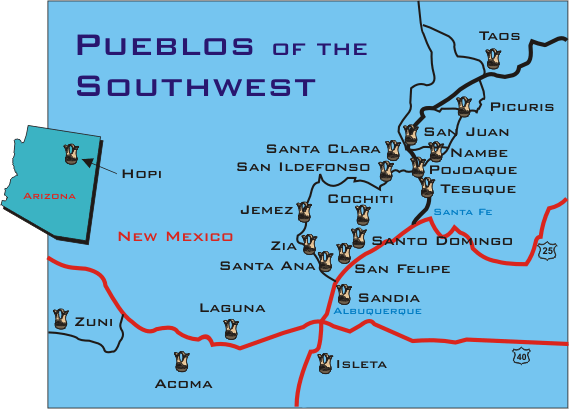 ClayHound Web
- San Ildefonso Pueblo
ClayHound Web
- San Ildefonso PuebloReturn to:
|
San Ildefonso Pueblo Pottery |
|
|
|
|
|
|
|
San Ildefonso Pueblo is located in North-central New Mexico. In contrast to the plain-ware tradition of the northern Tewa pueblos, the southern Tewa villages specialized in painted pottery throughout the Historic period (1600-1900).Until about 1730 the basic types were Sakona Polychrome and Tewa Polychrome. In the following twenty years of more these gradually evolved into two excellent types, Ogapoge Polychrome and Pojoaque Polychrome (Circa 1730-1760). Ogapoge Polychrome is decorated on both mid body and upper body, always with abundant feather symbols, and incorporates red into the motifs. it may have been manufactured for sacred ceremonial purposes exclusively. Pojoaque Polychrome jars have a splendid polished , tall, red upper body, a band of decoration on the mid body, and a red-banded underbody. After about 1760 the standard style for the area became the type known as Powhoge Polychrome, named for the Indian designation for San Ildefonso. This pottery type is especially noted for the superb large storage jars that were made at San Ildefonso and Tesuque pueblos.... At San Ildefonso the making of pottery declined considerably until by 1830 its decorated ceramic output was limited to large storage jars and a few smaller jars. Most small vessels were imported, principally from Nambe Pueblo, which received food and other items in return. This situation persisted until about 1880, when San Ildefonso pottery making underwent a tremendous revitalization, sparked by the influx of tourists arriving on the new cross-country railroad. Indeed, 1880 is reckoned as the earliest date for San Ildefonso Polychrome....about 1918 they found that if an unfired polished red vessel was painted with a certain mineral paint on top of the polish and fired in a smudging fire at a relatively cool temperature the result would be a deep glossy black background with dull black decoration...soon after the technique was much copied, but Maria Martinez's family remained its master. |
|
|
Like its Santa Clara neighbors, the ancestors of the Pueblo of San Ildefonso abandoned their original villages of Mesa Verde and Bandelier due to drastic changes in the environment. It was at Black Mesa that San Ildefonso along with other Pueblo people successfully held off Spanish soldiers during their re-conquest of New Mexico in 1694. San Ildefonso is best known to be the home of the late Maria Martinez who along with her husband, Julian, developed black-on-black pottery. Maria's work can be seen at the Pueblo museum located near the church.
|
|
|
from - http://www.newmexico.org/culture/pueblo_sanildefonso.html |
|



